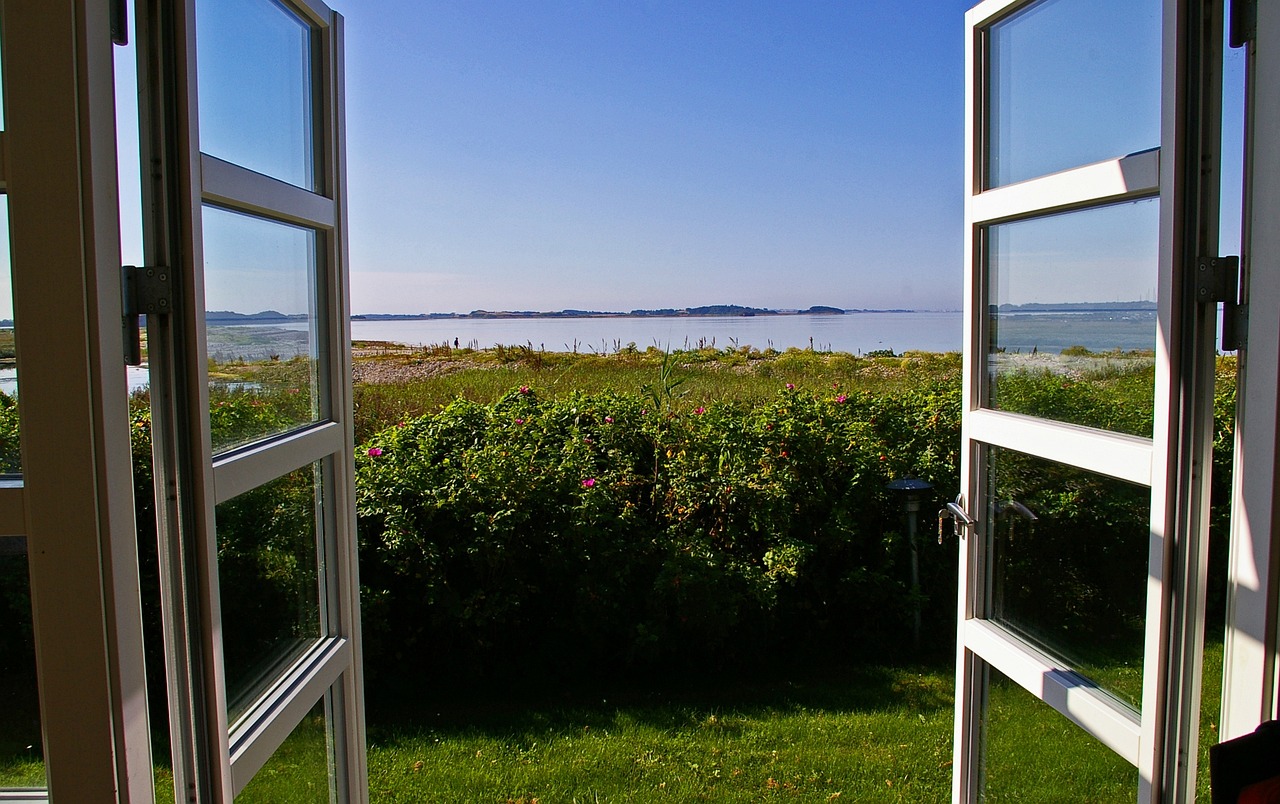If you’re designing your house, what if there was an easy way to make it more comfortable to live in, and cheaper to run, for free? And all you had to do was look at where you’re putting your windows and your eaves? Well, I’m happy to tell you that this is the magic of passive solar design…
What is passive solar design?
It’s passive because if you build it right in the first place, you don’t need to keep pouring energy into your house to keep it comfortable. And it’s solar because it has quite a bit to do with managing how and when you let sunshine get into your house – although it’s not only about the sun.
(and note that passive solar design is a different thing from a certified Passive House, or Passivhaus, which is a house that reaches a very high level of energy efficiency. They are connected though, because you’d find it tricky to build a Passive House without using good passive solar design. These principles are a basic aspect of the energy efficiency of any home. Achieving a full Passive House level of comfort and low bills though, is a tougher and more expensive threshold to reach.)
Good passive solar design can literally be free. Zero dollars and zero cents.
The sun is a powerful heat source
In my example here, with lots of glazing on the east and west sides of the house, you can see that pretty much no matter what you do, quite a bit of the sun’s heat is going to get into the house in the morning and afternoon:
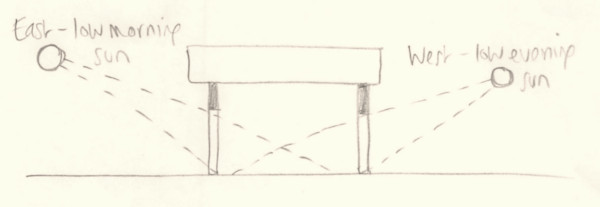
This might be great news in the winter, but not in the summer. In most climates, the ideal would be to keep the summer sun off your windows entirely, and to let as much sun onto your windows in the winter as possible.
Good design can let the sun in, and keep it out, exactly when you want it
At midday, the summer sun sits higher in the sky than the winter sun does. A handy side-effect of this is that, if you get your eaves right, then on the sunny side of your house, you can fully exclude the summer sun, but let the winter sun flood in, all without lifting a finger:
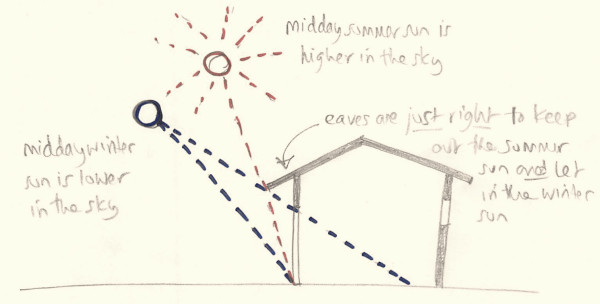
(The optimal angles for this depend on how far you are from the equator. I know the angles for Perth, and I thought I’d be able to find an easy calculator for you with angles for other locations, but wow, I just spent ten minutes hunting around the internet and now I have a headache. If you can find an easy reference source for this then let me know and I’ll add it in! And if you want to dig deeper into this, there is WAY more info on shading on the Australian government’s YourHome website.)
And make your home MUCH more comfortable
So without spending anything extra, if you are able to lay out your home (and its glazing and shading) like this, then its natural temperature all year round will be a lot more comfortable:
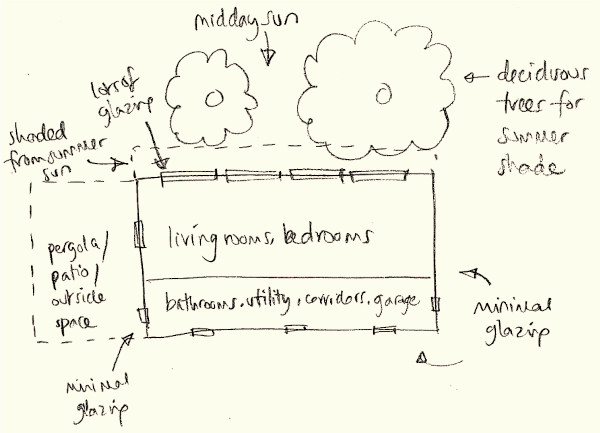
Seasonal shading
To take your design a bit further, or if your block doesn’t allow an ideal orientation for your house, you can also add some seasonal shading. Use deciduous vegetation, or summer shade sails, to increase your summer shade, without obstructing your winter sun:

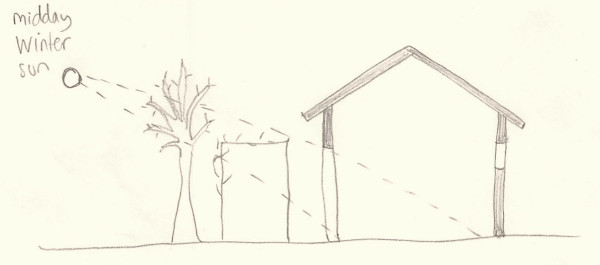
“I don’t need to worry about shading, I’m going to have tons of insulation”
No. Unfortunately, a well insulated home can make the problems of a poor passive solar design even worse. Once the summer sun gets in through your windows, if your walls are well insulated (and/or your airtightness is good), that heat has no-where to go. In summer your well-insulated but unshaded home may heat up, and up, and up.
“I don’t need to worry about shading, I’m going to have double glazing”
Also no. This is a common misconception, that double glazing will keep the radiant heat of the sun out of your house. That is not what double glazing is for.
Heat can be transferred by conduction (like when you touch a hot kettle), by radiation (like the rays of the sun warming your face even on a cold winter’s day), and by convection (like the hot air rising from the surface of a frying pan). Double glazing is designed to stop heat travelling between the hot outside air and the cold inside air (or vice versa), by CONDUCTION through your glazing. It will reduce your winter warmth escaping. It will reduce hot summer air heating up your inside air. But it will not stop the RADIANT heat of the sun’s rays coming in through your window. In fact, like the insulation and airtightness, it can INCREASE this problem. If the hot sunlight does get in, it can help to trap that heat inside.
(The glazing feature which CAN make a difference to how much radiant sun heat gets into your room is low-e glass. This has a coating to reduce its Solar Heat Gain Coefficient, or SHGC. Combined with double glazing, it can give your windows improved thermal performance at all times of day and year, but this is complex. For now I’ll just say that using good passive solar design will tend to give you a much better bang for your buck than trying to deal with the heat of the summer sun AFTER it has hit your windows.)
Cross-ventilation
Meanwhile, if you design in some windows to allow good cross-ventilation, then on cool summer evenings you can open your windows to help flush out the heat of the day:
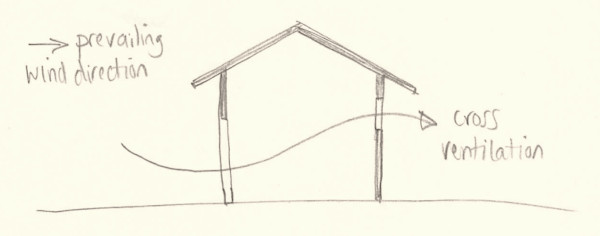
They do say that living in a passive solar house can be quite an active business – opening the windows to let in the cool air on a summer evening, or taking down a shade sail at the end of summer, are small jobs that can make a big difference to your home’s comfort.
Thermal mass
A reasonable level of thermal mass will be your friend here also. Materials with good thermal mass include concrete, brick, stone and water. They can hold a lot of heat, and they are slow to heat up or cool down. In your house, they can act as a kind of thermal battery, a delaying mechanism. If you leave your car out in the sun, its minimal thermal mass is one reason the air inside will get very hot very fast. If your house has maybe a concrete floor or brick walls, then even if the sun is hitting some of the windows, the air inside will heat up relatively slowly. After the sun goes down, it will also cool down slower.
In a good solar passive design, your thermal mass can magnify the benefits of controlling how much sun is getting in through your windows. If the winter sun is directly warming your concrete floor, some of that heat should stick around to keep you warm in the evening. In the summer, if you keep out the direct sun, and flush hot air out during the night, your concrete slab will stay cooler, and in the morning your internal air will heat up less rapidly.
(With enough thermal mass, like for example a rammed earth house, your house may maintain a pretty steady temperature throughout the day and night, which in a very moderate climate can be perfect. Although in some locations an uninsulated rammed earth house, which will gravitate towards the 24-hour average temperature, may not be comfortable in all seasons.)
Insulation, curtains, draughts
And if your passive solar design is good, insulation will also be your friend. Windows are a weak point in the thermal envelope of our homes, because there’s a tradeoff between thermal performance and other joys like daylight, views and connection to your garden. But of course your walls and roof will also lose and gain heat. Decent insulation may cost a bit extra when you build your house, but should save you money every year you live in it. Thick curtains can help a bit too. Not every valuable solution is high tech. If you’re limited in the changes you can make to your home, shading inside your windows is better than no shading at all. On winter nights, heavy curtains can provide some extra insulation and draught-proofing.
Doing some draught-proofing can also help you keep control over your home’s internal temperature. If your home is quite leaky, as soon as there’s a breeze, it will have air pretty much rushing through it. The external temperature and wind level will be in charge of how well you’re going to hang on to any nice cool air, or nice warm air, that you’ve created inside your home.
Passive solar design as a no-brainer
So, if your site allows it, and you are still at the design stage, implementing good passive solar design principles now may not cost you a penny. Getting your orientation, window locations, and shading right can boost your comfort, and save you money, for every year that you live in the house. Coolio!
Image by Kerstin Riemer from Pixabay

